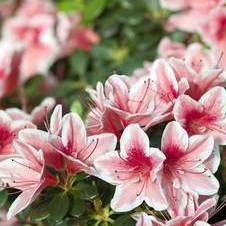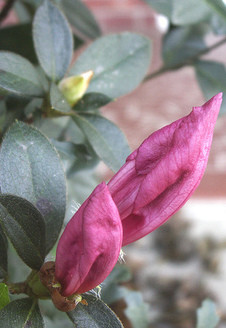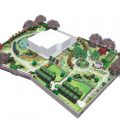 Azalea how to care forBeautifully flowering species and varietiesnative to China, Japan, Southeast Asia, Europe and North America. Funnel-shaped flowers - white, pink, crimson, bright red - single-color or two-color - are collected in racemes or corymbose. The most valuable varieties are those originating from the species Indian rhododendron and Sims's rhododendron, blooming with large flowers from winter until spring. Japanese azalea has small flowers, it blooms in April, sometimes at Christmas. In eastern countries, azaleas have been cultivated as the most beloved flowering plants since ancient times, their flowers are a symbol of joy, peace and freedom. With careful care, azaleas become more beautiful every year. After flowering, you need to cut off all faded flowers and thickened shoots (be careful: rhododendrons may contain toxic substances!). Pruning of shoots is necessary several times in early summer to form a lush bush. Also pinch young shoots that form immediately before or during flowering. Azaleas like light to partial shade, but do not tolerate the sun. Provide it with coolness (in autumn and winter 5-10 degrees for buds to ripen, when buds swell 18 degrees) and plenty of fresh air, from the beginning of May it can be kept outside in partial shade. Water with soft water, avoiding over-wetting or over-drying of the soil. In summer, water abundantly, in autumn, reduce watering to form buds. Spray in spring and summer. In summer, place the pot in a bucket of water for a short time once a month, wait for excess water to drain and put it back in place exactly as it stood on the windowsill (mark the pot with electrical tape), otherwise a change in position in relation to the light can cause the leaves to fall off.
Azalea how to care forBeautifully flowering species and varietiesnative to China, Japan, Southeast Asia, Europe and North America. Funnel-shaped flowers - white, pink, crimson, bright red - single-color or two-color - are collected in racemes or corymbose. The most valuable varieties are those originating from the species Indian rhododendron and Sims's rhododendron, blooming with large flowers from winter until spring. Japanese azalea has small flowers, it blooms in April, sometimes at Christmas. In eastern countries, azaleas have been cultivated as the most beloved flowering plants since ancient times, their flowers are a symbol of joy, peace and freedom. With careful care, azaleas become more beautiful every year. After flowering, you need to cut off all faded flowers and thickened shoots (be careful: rhododendrons may contain toxic substances!). Pruning of shoots is necessary several times in early summer to form a lush bush. Also pinch young shoots that form immediately before or during flowering. Azaleas like light to partial shade, but do not tolerate the sun. Provide it with coolness (in autumn and winter 5-10 degrees for buds to ripen, when buds swell 18 degrees) and plenty of fresh air, from the beginning of May it can be kept outside in partial shade. Water with soft water, avoiding over-wetting or over-drying of the soil. In summer, water abundantly, in autumn, reduce watering to form buds. Spray in spring and summer. In summer, place the pot in a bucket of water for a short time once a month, wait for excess water to drain and put it back in place exactly as it stood on the windowsill (mark the pot with electrical tape), otherwise a change in position in relation to the light can cause the leaves to fall off. Young plants are replanted annually, old onesOnce every 2-3 years in rhododendron soil (or prepare a mixture of peat, turf soil and sand in a ratio of 5:1:1), the plants do not tolerate lime. When replanting azaleas, it is undesirable to disturb the root ball (since there are useful soil fungi on the roots), instead of replanting, it is recommended to transship with the addition of fresh substrate. From the end of February to August, 2 times a month, feed with lime-free flower fertilizer, or add low-concentration rhododendron fertilizer to the water for irrigation. At too high temperatures and dry air, it is affected by spider mites, which can lead to yellowing and leaf fall. Spider mites or red spiders are very small sucking pests that form an interweaving of thin white threads on the underside of the leaves. Rinse the leaves of the plant with a stream of water from the shower, covering the ground with cellophane, and treat the leaves with the preparation until the pests disappear. Treatment with chemicals is undesirable in a living space due to their toxicity, so prepare and use herbal preparations: decoctions and infusions of tobacco, onions, garlic, pepper, yarrow, calendula, etc. Increase the frequency of spraying not only the plant itself, but also the space around it. Air humidity can be increased by using an electric humidifier, as well as by placing a wide, flat tray of water next to the plant. Azaleas are suitable for creating bonsai, but it should be taken into account that the trunk is a little brittle and when bending it carefully, it must be supported by hand. In the fall, the well-groomed azalea is given the desired shape (semi-cascade or panicle) and transplanted into a bonsai container.
Young plants are replanted annually, old onesOnce every 2-3 years in rhododendron soil (or prepare a mixture of peat, turf soil and sand in a ratio of 5:1:1), the plants do not tolerate lime. When replanting azaleas, it is undesirable to disturb the root ball (since there are useful soil fungi on the roots), instead of replanting, it is recommended to transship with the addition of fresh substrate. From the end of February to August, 2 times a month, feed with lime-free flower fertilizer, or add low-concentration rhododendron fertilizer to the water for irrigation. At too high temperatures and dry air, it is affected by spider mites, which can lead to yellowing and leaf fall. Spider mites or red spiders are very small sucking pests that form an interweaving of thin white threads on the underside of the leaves. Rinse the leaves of the plant with a stream of water from the shower, covering the ground with cellophane, and treat the leaves with the preparation until the pests disappear. Treatment with chemicals is undesirable in a living space due to their toxicity, so prepare and use herbal preparations: decoctions and infusions of tobacco, onions, garlic, pepper, yarrow, calendula, etc. Increase the frequency of spraying not only the plant itself, but also the space around it. Air humidity can be increased by using an electric humidifier, as well as by placing a wide, flat tray of water next to the plant. Azaleas are suitable for creating bonsai, but it should be taken into account that the trunk is a little brittle and when bending it carefully, it must be supported by hand. In the fall, the well-groomed azalea is given the desired shape (semi-cascade or panicle) and transplanted into a bonsai container.

Making Money with Desserts: Success Stories
Evgeniya Polischuk (Fedutinova) instagram:@evgeniyafedutinovavk.com/janeshomebaking– It all started with baking for family and friends. Gradually, I started posting photos of my baked goods on Instagram – and orders started coming in. I made my first custom-made cake on October 13, 2014, and a little earlier I started making macaroons and cupcakes. You could say that the business “found me”, I am very […]

Soups are cold recipes with photos
Cold cucumber soup with yogurt and lemonsorbet from the chef of the restaurant La Taverna Alexander Zhurkin Photo: Getty Images Ingredients: Plain yoghurt – 125 g Cucumber – 150 g Lemon/lime sorbet – 50 g Cocktail shrimp – 24 g Fresh ginger juice – 1 g Lime juice – 5 g Fresh orange juice – 5 g Parsley – 1 g Pink pepper – 1 g Watercress – […]

barbeque kebab
Pork tenderloin in glaze Photo:Dmitry Bayrak/dbstudioPreparation time: 20 minutes + marinating time.Calories: 454 kcal per serving.For 4 servings: 4 pork tenderloins (approximately 300 g each), 1 onion, 2 cloves of garlic, 1 tsp. lemon zest, 1 tsp. lemon juice, a pinch of ground cumin, coriander and turmeric, 1 tbsp. vegetable […]

Pierre Duacan: dietary recipes: Ducane diet
Beetroot soup Photo:Season’S, Luxury Hotels RepresentationYou will need:· Boiled beetroot – 60 g· Fresh cucumbers – 20 g· Red radish – 20 g· Green onions – 10 g· Egg – 1 pc.· Drinking mineral water – 200 g· Salt – 1 gPreparation:· Boil the egg and beetroot.· Grate the cucumbers, radish and part of the beetroot. Put everything […]





